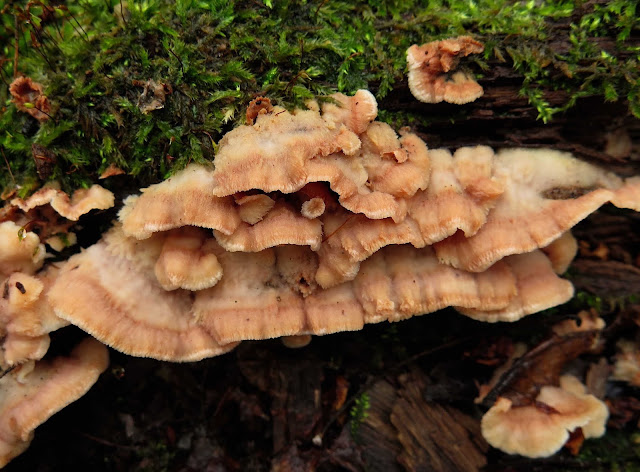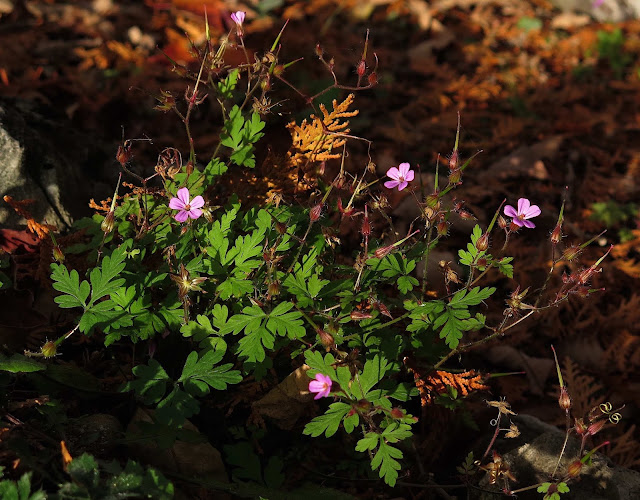Don't be fooled by the clear blue sky above the towering Saratoga Battle Monument. I actually took this photo on an earlier, sunnier day than this past cold and drizzly Wednesday, when my friend Sue Pierce and I parked at this Schuylerville monument to take a walk on the nearby Victory Woods trail.

It strikes me as somewhat odd that this woodland would be named Victory, since it was here in 1777 that British troops and their Loyalist supporters retreated after their sound defeat at the Battle of Saratoga in the Revolutionary War. But as they say, one side's defeat is another's victory, and the victors got to name the woods where the defeated ones -- starved, exhausted, and with many wounded -- took refuge, hoping to escape back to Canada with the remnants of their army. As part of the Saratoga National Historic Park, the trail now named Victory Woods passes through wooded acreage where the British hunkered down in misery, and a number of informational signs are posted along the trail, describing the history of the place. Four years ago, I posted a blog entry about Victory Woods, which you could visit by clicking here to learn more details about this site and its military history. As for Sue and me, we were here on this soggy day for a nature walk instead of a history lesson, and so we set off through the adjacent cemetery to reach the trailhead a hundred yards or so from the parking area.

The trail through 22 acres of a mixed hardwood forest offers level gravel paths as well as boardwalks, providing easy access to both the able-bodied and the handicapped. Occasional benches offer resting places, as well.
One of the first things we noticed on our nature walk was the abundance of small trees with big dangling leaves, sapling-size trees that did not resemble any of the tall oaks and maples that towered over them in the surrounding forest.
The leaves were huge, thin and soft, and of a shape completely unremarkable, with no lobes or hairs on the midribs or any discernible odor. The end of the leaf petiole, however, did taste slightly like Sassafras when I nibbled it. And the leaf fell away from its twig at a touch.
A close look at the end of a twig revealed a new bud that was covered with a pale pubescence, and I could also detect a stipule scar that completely encircled the twig. After posting these photos on a Facebook page dedicated to the flora of New York and asking for ID suggestions, these two features -- the pubescent bud and the encircling scar -- are what convinced several expert responders that this was a tree in the Magnolia Family. A Cucumber Magnolia (Magnolia acuminata), to be exact, a tree that is native to our northeastern region, including counties adjacent to Saratoga County. I never even knew that we had any native Magnolias around here! Facebook can be an amazing source of information!
Here was another organism I didn't recognize, a tight cluster of glossy-topped brown mushrooms that lay, unattached, at the base of a tree. Could these be Honey Mushrooms, I wondered, so shiny from being wet from the rain?
But then I turned the clump over and discovered that these mushrooms had inky-black stalks, unlike the brownish speckled stalks of Honey Mushrooms. Such a distinctive feature made a Google search promptly successful, and I soon learned that this was a cluster of Velvet Stalk Mushrooms (
Flammulina velutipes). A new one for me! After searching the web for more information about this species, I also learned that the tops are always glossy and sticky, so they weren't just wet from the rain. Some sites also claimed that this was the same species used to cultivate the long, skinny, white-capped Enoki mushrooms used in Japanese cuisine, although other sources claimed that Enokis are a different species. Interesting facts, to be sure, but mostly I was just delighted to have found such a beautiful mushroom and had come to know its name.
More interesting fungi lay in wait along the trail. A fallen log sported long ribbons of this pinky-orange wavy fungus, and at first I thought it might be one of the bracket fungi, either toothed or a polypore.
Since the spore surface would offer the surest clues to this fungus's ID, I peered at its underside and was surprised to find neither pores nor teeth, but rather glossy patches of wrinkled tissue. Aha! Now I remembered that I had found this fungus before, and I even remembered its name: Phlebia tremellosa. It's also known as Trembling Jelly Rot, a common and widely distributed wood-decay fungus that grows on the rotting wood of both hardwood and conifer logs.
A bit later, we found yet another interesting fungus, this one composed of tiny pinky-tan, furry-backed discs scattered across the trunk of a Hop Hornbeam tree. Its name, quite appropriately, is Hophornbeam Disc (
Aleurodiscus oakesii), although it can also be found on the bark of oaks or elms.
Although the Hophornbeam Disc Fungus decomposes the outer layer of bark, creating flat patches on the trunk, it doesn't harm the tree, since it feeds only on dead bark cells, not the tree's living wood tissue. This is not an uncommon fungus on living trees, but the disc-like fruiting bodies are seldom seen, according to several internet mushroom sites I consulted. I guess we were privileged characters, to have come upon this interesting fungus on our walk.
There was also an intriguing insect sharing this Hop Hornbeam bark. This was a Snowy Tree Cricket (Oecanthus fultoni) clinging to the rain-dampened trunk on this chilly day. Another name for this insect is Thermometer Cricket, for it is said that the air temperature can be calculated from the frequency of the cricket's chirps. Sadly, we didn't hear a single chirp from this cricket. It must have been feeling even colder than we did after an hour or so tramping about in this soggy woods.
This tiny Spring Peeper was lively enough, anyway. Both Sue and I had quite a time attempting to photograph the wee critter, frisky despite the chilly rain-wet leaves that it would disappear into as soon as we each got our cameras focused on it. I'm hoping Sue captured a clearer image than I did.



















































